The 55th International Art Exhibition – La Biennale di Venezia opens this week. As in the past, the artwork is presented under several groupings. There are many national representations (largely clustered in the Giardini Pubblici), and a whole host of what are known as “collateral events” sprinkled around the city. The main event, as far as critical attention goes, is a single large exhibition put together by a curator appointed by the President of the Biennale.
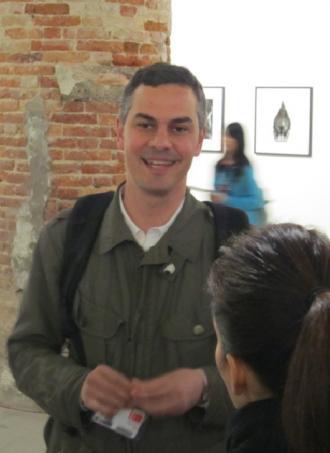
Curator Massimiliano Gioni in the Arsenale. photo: Marjorie Och
brought in 3 Tintorettos from the Accademia di Belle Arte to ground the Biennale in its Venetian location, and to open a discussion about the relationship of contemporary art to specifics of time and place. This year, curator Massimiliano Gioni opens with the hermetic drawings of psychoanalyst Carl Jung, and tarot card designs by the occultist Aleister Crowley, signaling this Biennale’s emphasis on the inward, the private, and the unseen.
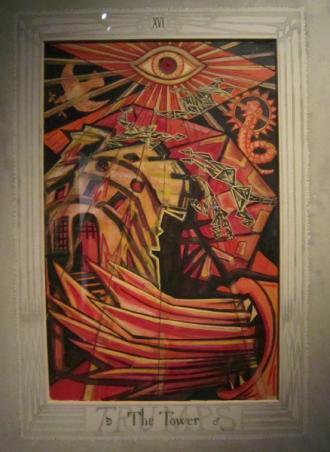
Aleister Crowley. Tarot card. 1938-43. photo: Marjorie Och
. – there are many more examples of things here than we are used to seeing in contemporary art exhibitions. Gioni organized his show around the concept of The Encyclopedic Palace, and the visitor moves back and forth from the natural world to the manmade, and from the invisible (spiritual, mental) to the visible. As the title suggests, this is a wide-ranging exhibition, encompassing a good bit of twentieth-century folk art and outsider art, in addition to the contemporary art for which the Biennale is best known.
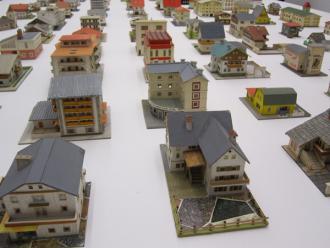
Peter Fritz. House models. cardboard. 1950s. photo: Marjorie Och
. Where is the art that responds to current political crises, the Euro Zone implosion, or continued terrorist threats? One might think contemporary artists have given up on engagement from the choices made here. One seeks in vain for answers to the housing crisis in the cardboard models from the 1950s of Viennese insurance clerk Peter Fritz.
There is a wunder kammer feel to many of the selections, and a sense that we are in a temporary museum rather than a kunsthalle. In part this is because the design of the spaces is much more museum-like than recent iterations: the “white cubing” of the Arsenale’s rough industrial walls is especially evident.
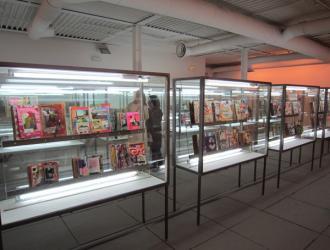
Shinro Ohtake. Scrapbooks #1-66. mixed media. 1977-2012.
photo: Marjorie Och
in large glass vitrines lit by harsh flourescent tubes seems purposely designed to evoke an outdated natural history display. The museum feel is underscored by the number of works from the late nineteenth or early twentieth century, and by art that deals with memory.
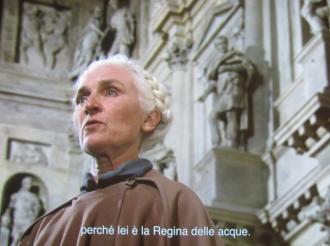
Aurélien Froment. Camillo’s Idea. video, 26’ 18”. 2013. photo: Marjorie Och
. Froment (b. 1976, Angers) offers us a video of a memory-expert on stage at the Teatro Olimpico in Vicenza. She recites the history of memory strategies including the Theater of Memory, a mental architecture used to “store” ideas for later retrieval (her recitation is from memory, of course).
Indeed, France is well represented here (as should be the birthplace of the Encyclopedie!), from the mystical paintings of outsider artist Augustin Lesage (1876-1954, Saint-Pierre-les-Auchel) to Laurent Montaron’s 2011 video essay on how technology dampens our ability to visualize abstract ideas.
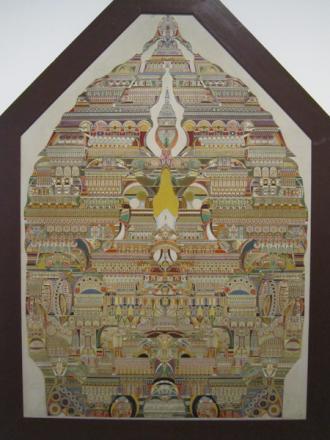
Augustin Lesage. Composition symbolique sut le monde spirituel. 1925. photo: Marjorie Och
the possible critical function of individual works, but the experience of walking through the galleries and being confronted with dozens, if not hundreds of like images, teaches other lessons. Italian artist Linda Fregni Nagler offers The Hidden Mother, nearly one thousand found photos of babies and young children, in all of which the mother is present but effaced in one way of another.
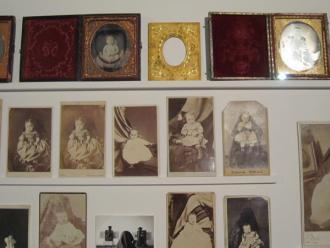
Linda Fregni Nagler, The Hidden Mother, 2006-2013. 997 collected daguerreotypes, tintypes, albumen prints, snapshots, detail. Photo: Marjorie Och.
(ranging from Daguerreotypes to modern silver gelatin prints) is disturbing. As with the obsessive repetitions of many outsider artists, Nagler’s decision to enumerate ad nauseam suggests a deep current within all of us, the voyeur’s addiction to ocular experience. Ed Atkin’s video of André Breton’s collection-filled home reminds us that “the energy of images must be dispersed.”
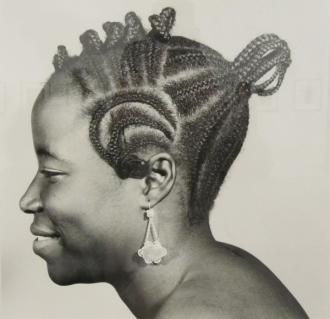
J. D. ‘Okhai Ojeikere. Untitled series. c1960-2000. detail. photo: Marjorie Och
opened with Carl Jung’s drawings and J. D. ‘Okhai Ojeikere’s photographs cataloguing Nigerian women’s hairstyles. It concludes with a set of Walter De Maria’s bronze rods. In the end, Gioni seems to be saying, we can travel to exotic places and explore our innermost thoughts, celebrate the esoteric and the occult, but the eternal verities of measure and proportion will remain. Of a durable material, and machined with great precision, De Maria’s cylinders are laid out on the gallery floor in a columnar fashion. Gioni leaves us not at the exit of a palace, but at the entrance to a Greek temple.
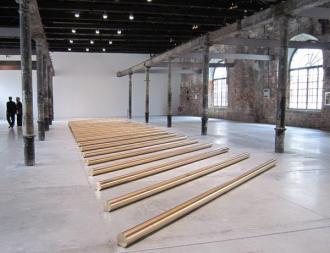
Walter De Maria. Solid bronze rods. photo: Marjorie Och
Lions:
GOLD Tino Sehgal, UK
SILVER Camille Henrot, Fr
Spec Mentions:
Sharon Hayes, USA [pers/public]
Roberto Cuoghi, Italy
PAV GOLD Angola
Lithuania/Cyprus
Japan (Shinro Ohtake)